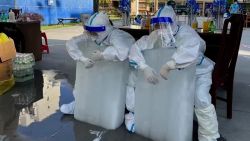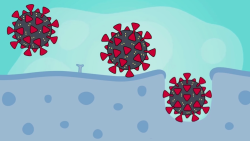A version of this story appeared in CNN’s What Matters newsletter. To get it in your inbox, sign up for free here.
Scientists around the world are racing to develop coronavirus vaccines and there’s news almost daily about steps forward.
This week a vaccine candidate developed by the biotechnology company Moderna has been found to induce immune responses in all of the volunteers who received it in a Phase 1 study.
These early results showed that the vaccine worked to trigger an immune response with mild side effects – fatigue, chills, headache, muscle pain, pain at the injection site. But the vaccine will still have to clear a large Phase 3 trial, expected to begin later this month, before regulators consider whether to make the vaccine available.
CNN spoke with Dr. Robert Murphy, a professor of infectious diseases at Northwestern University and the executive director of the Institute for Global Health, about where we are in the vaccine development process and what to expect in the coming months.
The conversation, conducted over the phone and lightly edited for flow, is below.
A realistic timeline
CNN: Could you give an overview of where we are in the US vaccine development process and what you think a realistic timeline to expect one would be?
RM: Well it’s moving at, as they say, warp speed. There are 200 vaccine development programs going on worldwide. We don’t even know – it’s probably more than that. Some of them have gone already through Phase 2 and are almost ready to go to Phase 3.
Moderna is the furthest along here. This has gotten a lot of US support. They just got $500 million to actually ramp up production of the vaccine. They claim they’ve identified their dose that they want to go forward with, but they haven’t even started Phase 3. So this is very unusual to start up production when you don’t even know if it works basically.
Now, you know they have – the antibody works, but you don’t know compared to placebo if it prevents infection.
So the gamble is the US government is going to give these companies huge chunks of money to ramp up production way before they even start Phase 3. And that way, if it does work the day that the study is proven to be safe and effective, they don’t have to take 6 to 12 months to make all the vaccine.
It’s a very different approach than it’s ever been done. And so Moderna and the Oxford group both claim that they will have a viable product by the end of this calendar year.
Science is moving faster than ever
CNN: Given that vaccine development is usually measured in years and not months, how is it that there are vaccine candidates ready to start Phase 3 trials?
RM: The technology has improved significantly.
All they needed was the genetic makeup – the structure. They needed the structure of the virus, which they got in January from the Chinese. And once that took off within, I think within 60 days, they had a vaccine candidate.
So the molecular techniques are incredible. I mean, think back to HIV, April 1981. They find this funny disease and it took two and a half years to even find out what caused it. It’s amazing what’s happened since 1981. The technology has just advanced and we’re reaping the benefits.
The other big difference with this is that it is an RNA virus and it’s a coronavirus, which SARS and MERS are. And so people were already working on a vaccine for those. They’re all very closely related.
So they already had experience with these coronaviruses and then the whole RNA virus thing, some of the drugs like with the Ebola and with hepatitis C, there’s a lot of similarities and some of the drugs can work for the other ones. They’ve tried to repurpose a bunch of drugs. It hasn’t really worked too well, but you know, they at least have categories of drugs that they can use to go forward.
What a rollout will look like
CNN: Once a vaccine is made available, what would the rollout look like? Is it reasonable to assume that certain demographics that are more vulnerable to the virus would get it first?
RM: Well, I’m not a registered public health official in the government, so it is going to be – if the current government stays in place there won’t be any plan.
If there is a new administration, there will most likely be some kind of central control, I think. For polio in the ’50s and ‘60s, they had the same thing. They had the vaccine and they rolled it out and they worked with the churches and the communities to really get everybody all at once.
So there was this massive rollout of the vaccine, but that took months. You can’t just say, ‘Send me 12 million vials of vaccine to Illinois.’ It is going to take a while to roll out.
If you’re going to do it quickly, you have to use something like existing retail groups, such as CVS or Walgreens or Walmart or something where they have some kind of medical something going on there, or just pharmacies, urgent care centers. You’re going to have to use basically every way possible to get as many people vaccinated as possible. Then of course you have the whole anti-vaccine group going on. So we’re not sure how many people are willing – are going to even be willing to take it. So that’s another thing.
Masks and vaccines
CNN: I’m glad you brought that up. Dr. Anthony Fauci has expressed specific concern about it. What should the government be doing now in terms of a vaccine education effort?
RM: Well, it’s the same thing with the masks. What would a successful prevention measure effort look like? You would have respected people and celebrities on posters and TV and radio and you would set an example at every level of the government and society promoting either the mask prevention or the vaccine.
You would have the President roll his shirt up and get the first dose. You need to send the signal that this is good.
CNN: Anything else you’d like to add?
RM: Well, the people that are afraid of vaccines, they’ve been hit with – there’s a lot of craziness out there.
Everything has to be put in perspective, think of what you get in a vaccine product. You’re talking about typically one or two cc’s of the vaccine protein itself, whatever it is.
And there are preservatives in there, but they’re really in these minuscule amounts. Consider the air we breathe, consider the water we are drinking, consider our environment and the food we’re eating, all the stuff that’s in there now – what’s in the vaccine is nothing compared to the stuff we are exposed to every day.
People don’t realize that. I mean if you stay in the garage with the motor running in your car, you’ll be dead in an hour. And cars are driving around all over the place. They’re really polluting and the power plants and everything. I mean, you got to put all this into perspective, right?
Do you want to live with this pandemic or don’t you?




















